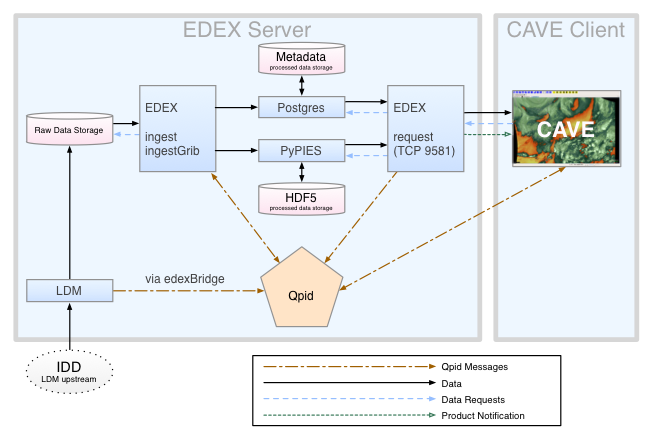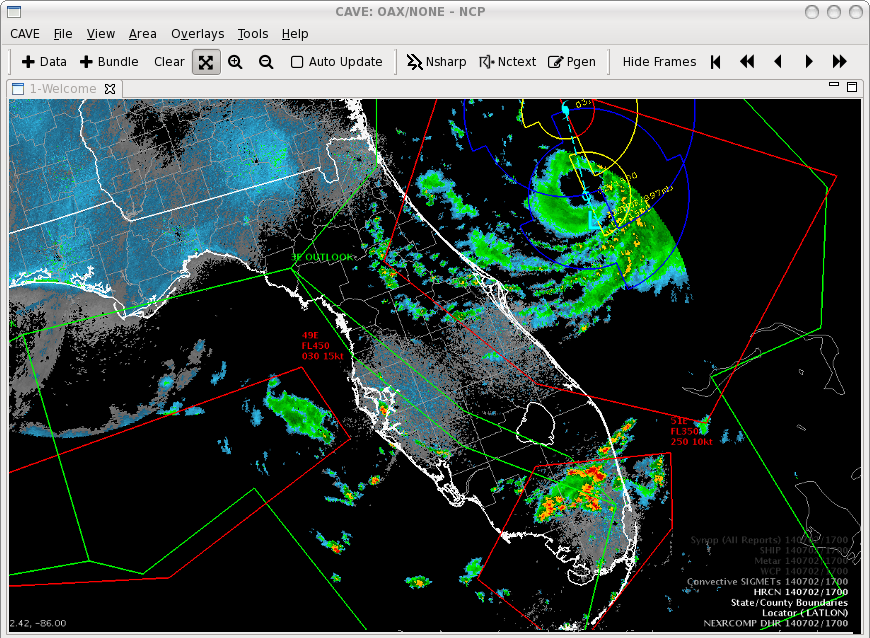About Unidata AWIPS
AWIPS is a weather forecasting display and analysis package developed by the National Weather Service and Raytheon. AWIPS is a Java application consisting of a data-rendering client (CAVE, which runs on Red Hat/CentOS Linux and Mac OS X) and a backend data server (EDEX, which runs only on Linux)
AWIPS takes a unified approach to data ingest, and most data types follow a standard path through the system. At a high level, data flow describes the path taken by a piece of data from its source to its display by a client system. This path starts with data requested and stored by an LDM client and includes the decoding of the data and storing of decoded data in a form readable and displayable by the end user.
The AWIPS ingest and request processes are a highly distributed system, and the messaging broken Qpid is used for inter-process communication.

image
License
The AWIPS software package released by the Unidata Program Center is considered to be in the public domain since it is released without proprietary code. As such, export controls do not apply. Any person is free to download, modify, distribute, or share Unidata AWIPS in any form. Entities who modify or re-distribute Unidata AWIPS software are encouraged to conduct their own FOSS/COTS entitlement/license review to ensure that they remain compatible with the associated terms (see FOSS_COTS_License.pdf at https://github.com/Unidata/awips2).
About AWIPS
The primary AWIPS application for data ingest, processing, and storage is the Environmental Data EXchange (EDEX) server; the primary AWIPS application for visualization/data manipulation is the Common AWIPS Visualization Environment (CAVE) client, which is typically installed on a workstation separate from other AWIPS components.
In addition to programs developed specifically for AWIPS, AWIPS uses several commercial off-the-shelf (COTS) and Free or Open Source software (FOSS) products to assist in its operation. The following components, working together and communicating, compose the entire AWIPS system.
EDEX
The main server for AWIPS. Qpid sends alerts to EDEX when data stored
by the LDM is ready for processing. These Qpid messages include file
header information which allows EDEX to determine the appropriate data
decoder to use. The default ingest server (simply named ingest) handles
all data ingest other than grib messages, which are processed by a
separate ingestGrib server. After decoding, EDEX writes metadata to the
database via Postgres and saves the processed data in HDF5 via PyPIES. A
third EDEX server, request, feeds requested data to CAVE clients. EDEX
ingest and request servers are started and stopped with the commands
edex start and edex stop, which runs the system script
/etc/rc.d/init.d/edex_camel
CAVE
Common AWIPS Visualization Environment. The data rendering and
visualization tool for AWIPS. CAVE contains of a number of different
data display configurations called perspectives. Perspectives used in
operational forecasting environments include D2D (Display
Two-Dimensional), GFE (Graphical Forecast Editor), and NCP
(National Centers Perspective). CAVE is started with the command
/awips2/cave/cave.sh or cave.sh

CAVE
Alertviz
Alertviz is a modernized version of an AWIPS I application, designed to present various notifications, error messages, and alarms to the user (forecaster). AlertViz can be executed either independently or from CAVE itself. In the Unidata CAVE client, Alertviz is run within CAVE and is not required to be run separately. The toolbar is also hidden from view and is accessed by right-click on the desktop taskbar icon.
LDM
http://www.unidata.ucar.edu/software/ldm/
The LDM (Local Data Manager), developed and supported by Unidata, is
a suite of client and server programs designed for data distribution,
and is the fundamental component comprising the Unidata Internet Data
Distribution (IDD) system. In AWIPS, the LDM provides data feeds for
grids, surface observations, upper-air profiles, satellite and radar
imagery and various other meteorological datasets. The LDM writes data
directly to file and alerts EDEX via Qpid when a file is available for
processing. The LDM is started and stopped with the commands
edex start and edex stop, which runs the commands
service edex_ldm start and service edex_ldm stop
edexBridge
edexBridge, invoked in the LDM configuration file
/awips2/ldm/etc/ldmd.conf, is used by the LDM to post “data
available” messaged to Qpid, which alerts the EDEX Ingest server that a
file is ready for processing.
Qpid
Apache Qpid, the Queue Processor Interface Daemon, is the messaging
system used by AWIPS to facilitate communication between services.
When the LDM receives a data file to be processed, it employs
edexBridge to send EDEX ingest servers a message via Qpid. When EDEX
has finished decoding the file, it sends CAVE a message via Qpid that
data are available for display or further processing. Qpid is started
and stopped by edex start and edex stop, and is controlled by
the system script /etc/rc.d/init.d/qpidd
PostgreSQL
PostgreSQL, known simply as Postgres, is a relational database
management system (DBMS) which handles the storage and retrieval of
metadata, database tables and some decoded data. The storage and reading
of EDEX metadata is handled by the Postgres DBMS. Users may query the
metadata tables by using the termainal-based front-end for Postgres
called psql. Postgres is started and stopped by edex start and
edex stop, and is controlled by the system script
/etc/rc.d/init.d/edex_postgres
HDF5
Hierarchical Data Format (v.5) is
the primary data storage format used by AWIPS for processed grids,
satellite and radar imagery and other products. Similar to netCDF,
developed and supported by Unidata, HDF5 supports multiple types of data
within a single file. For example, a single HDF5 file of radar data may
contain multiple volume scans of base reflectivity and base velocity as
well as derived products such as composite reflectivity. The file may
also contain data from multiple radars. HDF5 is stored in
/awips2/edex/data/hdf5/
PyPIES (httpd-pypies)
PyPIES, Python Process Isolated Enhanced Storage, was created for AWIPS to isolate the management of HDF5 Processed Data Storage from the EDEX processes. PyPIES manages access, i.e., reads and writes, of data in the HDF5 files. In a sense, PyPIES provides functionality similar to a DBMS (i.e PostgreSQL for metadata); all data being written to an HDF5 file is sent to PyPIES, and requests for data stored in HDF5 are processed by PyPIES.
PyPIES is implemented in two parts: 1. The PyPIES manager is a Python
application that runs as part of an Apache HTTP server, and handles
requests to store and retrieve data. 2. The PyPIES logger is a Python
process that coordinates logging. PyPIES is started and stopped by
edex start and edex stop, and is controlled by the system script
/etc/rc.d/init.d/https-pypies